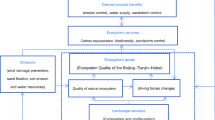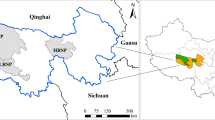Abstract
Twenty-one typical coupled large samples were chosen from areas within and surrounding nature reserves on the Tibetan Plateau using the large sample comparison method (LSCM). To evaluate the effectiveness of the nature reserves in protecting the ecological environment, the alpine grassland net primary production (NPP) of these coupled samples were compared and the differences between them before and after their establishment as protected areas were analyzed. The results showed that: (1) With respect to the alpine grassland NPP, the ecological and environmental conditions of most nature reserves were more fragile than those of the surrounding areas and also lower than the average values for the Tibetan Plateau. (2) Of the 11 typical nature reserves selected, the positive trend in the NPP for Manzetang was the most significant, whereas there was no obvious trend in Taxkorgan. With the exception of Selincuo, the annual NPP growth rate in the nature reserves covered by alpine meadow and wetland was higher than that in nature reserves consisting of alpine steppe and alpine desert. (3) There were notable findings in 21 typical coupled samples: (a) After the establishment of the nature reserves, the annual rate of increase in the NPP in 76% of samples inside nature reserves and 82% of samples inside national nature reserves was higher than that of the corresponding samples outside nature reserves. (b) The effectiveness of ecological protection of the Mid-Kunlun, Changshagongma, Zoige and Selincuo (Selin Co) nature reserves was significant; the effectiveness of protection was relatively significant in most parts of the Sanjiangyuan and Qiangtang nature reserves, whereas in south-east Manzetang and north Taxkorgan the protection effectiveness was not obvious. (c) The ecological protection effectiveness was significant in nature reserves consisting of alpine meadow, but was weak in nature reserves covered by alpine steppe. This study also shows that the advantage of large sample comparison method in evaluating regional ecology change. Careful design of the samples used, to ensure comparability between the samples, is crucial to the success of this LSCM.
Similar content being viewed by others
References
Andam K S, Ferraro P J, Pfaff A et al., 2008. Measuring the effectiveness of protected area networks in reducing deforestation. Proceedings of the National Academy of Sciences USA, 105(42): 16089–16094.
Bruner A G, Gullison R E, Rice R E et al., 2001. Effectiveness of parks in protecting tropical biodiversity. Science, 291: 125–128.
Caro T, Gardner T A, Stoner C et al., 2009. Assessing the effectiveness of protected areas: Paradoxes call for pluralism in evaluating conservation performance. Diversity and Distributions, 15: 178–182.
Chang H Q, Xu W Y, Yuan J et al., 2012. Current situation of grassland resources and grazing capacity in Ali, Tibet. Pratacultural Science, 29(11): 1660–1664. (in Chinese)
Chen B X, Zhang X Z, Tao J et al., 2014. The impact of climate change and anthropogenic activities on alpine grassland over the Qinghai-Tibet Plateau. Agricultural and Forest Meteorology, 189: 11–18.
Chen J K, 2012. Insights into the history of conservation of natural wetlands in China. Chinese Science Bulletin, 57(4): 205–206. (in Chinese)
Chen J K, Lei G C, Wang X L, 2010. Analysis of Ten Effective Management Case in the Middle and Lower Reaches of the Yangtze River. Shanghai: Fudan University Press. (in Chinese)
Crabtree R, Potter C, Mullen R et al., 2009. A modeling and spatio-temporal analysis framework for monitoring environmental change using NPP as an ecosystem indicator. Remote Sensing of Environment, 113(7): 1486–1496.
Cui G F, 2004. Special research fields and hot spots in science of nature reserves. Journal of Beijing Forestry University, 26(6): 102–105. (in Chinese)
Curran L M, Trigg S N, McDonald A, 2004. Lowland forest loss in protected areas of Indonesian Borneo. Science, 303: 1000–1003.
Dai L D, Min H X, 2009. Countermeasures on the sustainable development of Manzetang wetland nature reserve in Sichuan. Sichuan Forestry Exploration and Design, (4): 39–42. (in Chinese)
Deng M L, Tian K, Duan Z L et al., 2010. The changes of landscape at Zoige Plateau wetland reserve in Sichuan, China. Journal of Mountain Science, 28(2): 240–246. (in Chinese)
Department of Environment Protection of Qinghai Province, Bureau of Quality and Technology Supervision of Qinghai Province (DEPQP), 2015. Local Standard of Qinghai Province-Technical Specification for Evaluation on Ecological Effect of Ecological Protection and Construction of Three-Rivers Nature Reserve (DB63/T1342-2015).
Ewers R M, Rodrigues A S L, 2008. Estimates of reserve effectiveness are confounded by leakage. Trends in Ecology & Evolution, 23(3): 113–116.
Glindermann T, Wang C, Tas B M et al., 2009. Impact of grazing intensity on herbage intake, composition, and digestibility and on live weight gain of sheep on the Inner Mongolian steppe. Livestock Science, 124: 142–147.
Leverington F, Costa K L, Pavese H et al., 2010. A global analysis of protected area management effectiveness. Environmental Management, 46: 685–698.
Liu J, Li S, Ouyang Z et al., 2008. Ecological and socioeconomic effects of China’s policies for ecosystem services. Proceedings of the National Academy of Sciences, 105: 9477–9482.
Liu J G, Linderman M, Ouyang Z Y et al., 2001. Ecological degradation in protected areas: The case of Wolong Nature Reserve for Giant Pandas. Science, 292: 98–101.
Liu J Y, Shao Q Q, Fan J W, 2013. Ecological construction achievements assessment and its revelation of ecological project in Three Rivers Headwaters Region. Chinese Journal of Nature, 35(1): 40–46. (in Chinese)
Ma J Z, 1992. Science of Nature Conservation. Harbin: Northeast Forestry University Press. (in Chinese)
Mas J, 2005. Assessing protected area effectiveness using surrounding (buffer) areas environmentally similar to the target area. Environmental Monitoring and Assessment, 105: 69–80.
Melillo J M, Mcguire A D, Kicklighter D W et al., 1993. Global climate-change and terrestrial net primary production. Nature, 363(6426): 234–240.
Mittermeier R A, Turner W R, Larsen F W et al., 2011. Global Biodiversity Conservation: the Critical Role of Hotspots. In: Zachos F E, Habel J C. Biodiversity Hotspots. Berlin & Heidelberg: Springer, 3–22.
Naidoo R, Balmford A, Ferraro P J et al., 2006. Integrating economic costs into conservation planning. Trends in Ecology & Evolution, 21: 681–687.
Nan W Y, 2013. On the unification of Qinghai-Tibet High Plateau nature and ecology projection. Tibetan Studies, (4): 44–51. (in Chinese)
Naughton-Treves L, Holland M, Brandon K, 2005. The role of protected areas in conserving biodiversity and sustaining local livelihoods. Annual Review of Environment and Resources, 30: 219–252.
Potter C S, Randerson J T, Field C B et al., 1993. Terrestrial ecosystem production: A process model-based on global satellite and surface data. Global Biogeochemical Cycles, 7(4): 811–841.
Quan J, Ouyang Z Y, Xu W H et al., 2009. Management effectiveness of China nature reserves: Status quo assessment and counter measures. Chinese Journal of Applied Ecology, 20(7): 1739–1746. (in Chinese)
Radeloff V C, Stewart S I, Hawbaker T J, 2010. Housing growth in and near United States protected areas limits their conservation value. Proceedings of the National Academy of Sciences, 107(2): 940–945.
Running S W, Nemani R R, Heinsch F A et al., 2004. A continuous satellite-derived measure of global terrestrial primary production. Bioscience, 54(6): 547–560.
Shao Q Q, Fan J W et al., 2012. Integrated Monitoring and Assessment of Ecosystem in the Source Regions of Three Rivers, China. Beijing: Science Press. (in Chinese)
Shvidenko A Z, Schepashchenko D G, Vaganov E A et al., 2008. Net primary production of forest ecosystems of Russia: A new estimate. Doklady Earth Sciences, 421(2): 1009–1012.
Stoner C, Caro T, Mduma S et al., 2007. Assessment of effectiveness of protection strategies in Tanzania based on a decade of survey data for large herbivores. Conservation Biology, 21: 635–646.
Sun H L, Zheng D, Yao T D et al., 2012. Protection and construction of the national ecological security shelter zone on Tibetan Plateau. Journal of Geographical Sciences, 67(1): 3–12. (in Chinese)
Underwood F M, 2012. A framework for adapting survey design through time for wildlife population assessment. Environmental and Ecological Statistics, 19: 413–436.
Victoria C J, Cheng M S, Chen X W, 2002. The development of Landscape Analysis of Wetland Function (LAWF): A GIS-based wetland functional assessment tool. Proceedings of the Water Environment Federation, Watershed, 418–424.
Wang W, Pechacek P, Zhang M et al., 2013. Effectiveness of nature reserve system for conserving tropical forests: A statistical evaluation of Hainan Island, China. PLoS ONE, 8(2): e57561.
Wang X P, Cui G F, 2003. Nature Reserve Construction and Management. Beijing: Chemical Industry Press. (in Chinese)
Yan Y Y, Deng J, Zhang Z Q et al., 2014. Research progress in the protection efficacy evaluation of wildlife nature reserves. Chinese Journal of Ecology, 33(4): 1128–1134. (in Chinese)
Yan Y Y, Yang D D, Deng J et al., 2015. Construction of an indicator system for evaluating the protection efficacy of national nature reserves in China: A case study on terrestrial vertebrates (excluding migratory birds). Chinese Journal of Applied Ecology, 26(5): 1571–1578. (in Chinese)
Yang R R, 2002. Present situation of grassland degeneration and prevention measure in Ali Region, Xizang. Grassland of China, 24(1): 62–68. (in Chinese)
Yue P C, Dai J, Li D L et al., 2011. Major issues and countermeasure in the husbandry evelopment in Tashikuergan County. Grass-Feeding Livestock, (4): 21–23. (in Chinese)
Zhang H Z, Lu H Y, Hong J C et al., 2013a. Climate change and its effect on steppe animal husbandry in Northwest Tibet. Arid Zone Research, 30(2): 308–314. (in Chinese)
Zhang R Z, Li B Y, Zhang H X et al., 2012. Regional System of Natural Reserves in China. Beijing: China Environmental Science Press. (in Chinese)
Zhang W, 2007. Research of land use/cover classification and carbon stocks: A case study on Tibetan Plateau [D]. Beijing: Graduate University of Chinese Academy of Sciences. (in Chinese)
Zhang Y L, Li B Y, Zheng D, 2002. A discussion on the boundary and area of the Tibetan Plateau in China. Geographical Research, 21(1): 1–8. (in Chinese)
Zhang Y L, Qi W, Zhou C P et al., 2014. Spatial and temporal variability in the net primary production of alpine grassland on the Tibetan Plateau since 1982. Journal of Geographical Sciences, 24(2): 269–287.
Zhang Y L, Wang Z F, Wang X H et al., 2013b. Land cover changes in the key regions and self reflection on ecological construction of the Tibetan Plateau. Chinese Journal of Nature, 35(3): 187–192. (in Chinese)
Zhang Y L, Wu X, Qi W et al., 2015. Characteristics and protection effects of the nature reserves in Tibetan Plateau, China. Resources Science, 37(7): 1455–1464. (in Chinese)
Zheng Y M, Zhang H Y, Niu Z G et al., 2012. Protection efficacy of national wetland reserves in China. Chinese Science Bulletin, 57(4): 207–230. (in Chinese)
Zheng Y W, Xue D Y, Zhang G S, 1994. Study on ecological evaluation criteria and standards for nature reserves in China. Rural Eco-Environment, 10(3): 22–25. (in Chinese)
Author information
Authors and Affiliations
Corresponding author
Additional information
Foundation: The Strategic Priority Research Program of the Chinese Academy of Sciences, No.XDB03030500; National Key Technology Research and Development Program, No.2013BAC04B02; Key Foundation Project of Basic Work of the Ministry of Science and Technology of China, No.2012FY111400; National Natural Science Foundation of China, No.41171080, No.41201095
Author: Zhang Yili (1962–), Professor, specialized in physical geography and biogeography.
This paper has been published in Chinese and revised partially.
Rights and permissions
About this article
Cite this article
Zhang, Y., Hu, Z., Qi, W. et al. Assessment of effectiveness of nature reserves on the Tibetan Plateau based on net primary production and the large sample comparison method. J. Geogr. Sci. 26, 27–44 (2016). https://doi.org/10.1007/s11442-016-1252-9
Received:
Accepted:
Published:
Issue Date:
DOI: https://doi.org/10.1007/s11442-016-1252-9




